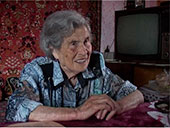
Tsilia Khaiut was born in 1917 in Mohyliv-Podilskyy. Her father, also from Mohyliv-Podilskyy, was a cobbler. Her mother came from the Bessarabian region, near Mykolaiv. She attended two Yiddish schools and finished her education in 1934. She had two sisters and a brother. She survived the war in the Mohyliv-Podilskyy ghetto and a concentration camp in Transnistria.
Money from America
Mohyliv-Podilskyy, Ukraine
In 1931, the Soviet central government’s insistence on meeting outrageous procurement quotas and their obstinate refusal to yield to local needs, combined with climactic conditions, created a massive famine in 1932–1933 that left some 2.5 to 3.5 million people dead. Today, many historians believe the famine was manufactured as a deliberate policy to punish the people of Ukraine for their resistance to collectivization. Some view it as a counterpart to the Holocaust and have come to understand it as “the Hidden Holocaust” or the “Unknown Holocaust.” Even the neologism commonly used to describe the 1932–1933 famine, Holodomor—literally, murder by famine—is a semantic counterpart to Holocaust, complete with the same first four letters of the word.
Some Jews managed to survive because they still had relatives in America who could help provide for them. In this clip, Tsilia Khaiut, who was born in Mohyliv-Podilskyy in 1917, explains that her maternal grandparents would send money from America, which her parents would keep in U.S. funds, recognizing that the exchange rates rendered their remittances worthless.Although an untold number of Jews died of starvation during the Great Famine, the ability of some to survive on the basis of foreign currency and political clout has contributed to the false perception, often manipulated for political reasons today, that Jews were the instigators rather than among the victims of the Great Famine.
Source: Jeffrey Veidlinger, In the Shadow of the Shtetl: Small-Town Jewish Life in Soviet Ukraine (Indiana University Press, 2013)
